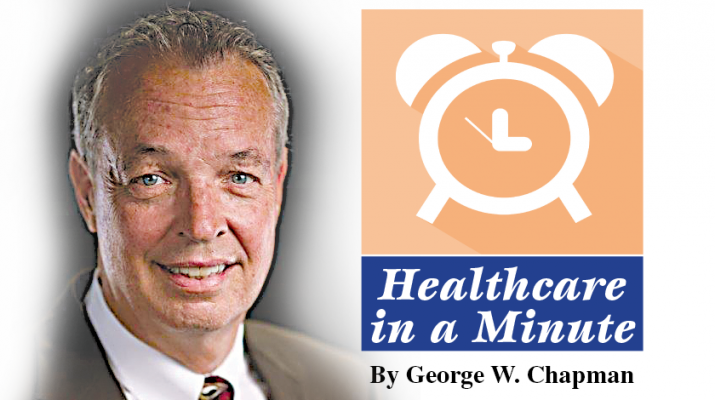By George W. Chapman
The American College of Physicians — with about 160,000 members — joins the ranks of physician organizations to endorse some sort of universal coverage or single payer healthcare system.
Historically, most physician groups have resisted any form of increased government involvement. Several factors contribute to this gradual about-face. Millions of patients still struggle with paying their medical bills, including those with insurance. Medical debt is the No. 1 reason for personal bankruptcies. Over the past 30 years, commercial insurance carriers have gradually lowered their payments to physicians to Medicare levels. Consequently, there is less support for multiple payers and more for a single payer if fees are about the same. More and more Americans are not covered by employer sponsored insurance. The percentage of Americans covered by some sort of federal program now exceeds 50%: Medicare, Medicaid, VA and military, federal employees, Bureau of Indian Affairs and the Affordable Care Act. The aging of America means Medicare is the fastest growing insurance plan. Dealing with multiple insurance plans is a cost and bureaucratic nightmare for physicians and their staff. A single payer would significantly lower practice overhead. According to a study in the Annals of Internal Medicine, a single payer system would reduce administrative costs by $600 billion annually. Finally, increasingly, younger physicians and recent grads prefer employment with larger health systems vs. private practice. Consequently, they are less resistant to government intervention if it guarantees access and affordability.
Easing MD Shortage
Physician assistants (PAs) and nurse practitioners (NPs) are both considered to be advanced practitioners (APs). Both of these professionals are helping to mitigate the increasing shortage of physicians, especially in primary care. The likelihood of being seen by an AP in any setting (private practice, urgent care or clinic) increases every year. There are approximately 125,000 PAs and 270,000 NPs in addition to about 950,000 active/practicing physicians. (PAs have only existed since 1967.) This year, PA schools will be required to offer a master’s degree. PAs must complete 100 hours of continuing education every two years. PAs are “certified,” but they do not have licenses. They operate under the license of a supervising physician. Nurse practitioners have their own license and many states allow them to practice independently from physicians. “Nurse practitioner” is a master’s degree. Both APs have seen rapid growth over the past decade.
The Coronavirus Vs. the Flu
With the coronavirus grabbing the headlines, we forget how pervasive and deadly influenza can be. Five to 20% of us (or 16 million to 66 million of us) will contract the flu every year. About 200,000 of us will be hospitalized every year with the flu on average, costing $10 billion a year. The corona virus, so named for its crown-like spikes, is unknown so its spread causes alarm. On top of it all, infectious disease experts (ID docs) are a dying breed. There has been a 40% decrease in medical students enrolling in ID training programs or residencies between 2009 and 2017. Infectious disease is one of just two subspecialties where not all residency slots are filled. Telemedicine can help by transmitting increasingly rare and valuable expertise to physicians working in even the remotest areas. Telemedicine also allows physicians to treat patients remotely, keeping them from coming into emergency facilities and offices and infecting provider staffs and other patients.
Request for Copy of Your Record
There is typically no charge when you approve or request the transfer of your record from one provider to another.
Up until recently, when you requested a copy of your record be sent to a third party, like a law firm, the provider could charge you, but not more than an imposed cap of $6.50 regardless of the record format, like digital or paper. In January, a federal judge eliminated the cap on what you could be charged as arbitrary and capricious. Healthcare lawyers are challenging the ruling.
Drug Price “Uncontrol”
In his State of the Union address, President Trump once again called for legislation to bring drug prices under control. The House bipartisan bill authorizing Centers for Medicare & Medicaid Services (CMS) to negotiate drug prices on behalf of the 165 million people covered by Medicare and Medicaid remains stalled in the Senate. Sen. Chuck Grassley, a Republican, spearheaded the bipartisan bill. Opponents of the bill have argued that negotiating prices is a form of “socialism.” The rather timid bipartisan bill would authorize CMS to negotiate just 25 prices the first year, then ramp up to more over 10 years. Drug prices remain totally unchecked while CMS literally sets prices and fees for physicians and hospitals.
Surprise Billing
Out-of-network providers and insurance companies have been feuding over how to settle surprise billing.
Currently, the consumer is stuck with paying the difference between what the out-of-network provider charges and what their insurance company thinks is reasonable. Congress’ Ways and Means Committee has suggested a two-step process to resolve the dilemma. First, the provider and the patient’s insurance company have 30 days to resolve the dispute between themselves. If they can’t, step two involves a third-party mediator. The vast majority of surprise billing emanates from a visit to an emergency room. The bill proposes giving patients an “advance explanation of benefits” including a cost estimate of what they will owe out of pocket which is alright in non-emergent situations. However, the Emergency Medical Treatment and Active Labor Act (EMTALA) requires hospitals to treat patients regardless of their ability to pay.
George W. Chapman is a healthcare business consultant who works exclusively with physicians, hospitals and healthcare organizations. He operates GW Chapman Consulting based in Syracuse. Email him at gwc@gwchapmanconsulting.com.

